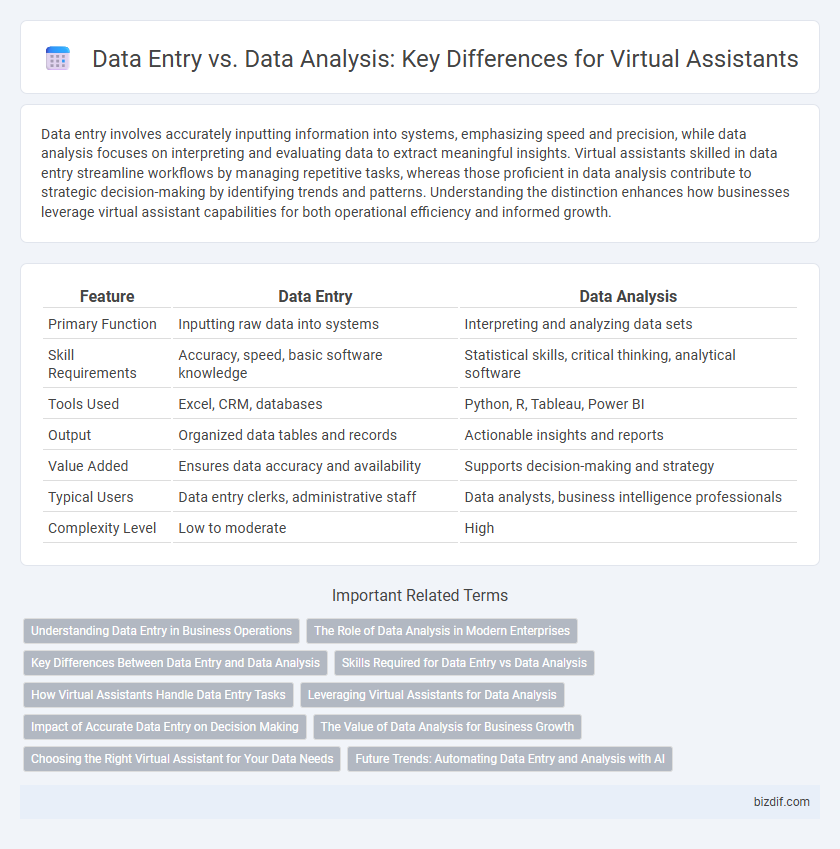Data entry involves accurately inputting information into systems, emphasizing speed and precision, while data analysis focuses on interpreting and evaluating data to extract meaningful insights. Virtual assistants skilled in data entry streamline workflows by managing repetitive tasks, whereas those proficient in data analysis contribute to strategic decision-making by identifying trends and patterns. Understanding the distinction enhances how businesses leverage virtual assistant capabilities for both operational efficiency and informed growth.
Table of Comparison
| Feature | Data Entry | Data Analysis |
|---|---|---|
| Primary Function | Inputting raw data into systems | Interpreting and analyzing data sets |
| Skill Requirements | Accuracy, speed, basic software knowledge | Statistical skills, critical thinking, analytical software |
| Tools Used | Excel, CRM, databases | Python, R, Tableau, Power BI |
| Output | Organized data tables and records | Actionable insights and reports |
| Value Added | Ensures data accuracy and availability | Supports decision-making and strategy |
| Typical Users | Data entry clerks, administrative staff | Data analysts, business intelligence professionals |
| Complexity Level | Low to moderate | High |
Understanding Data Entry in Business Operations
Data entry involves accurately inputting and updating information into digital systems, ensuring the integrity and organization of business records. It forms the foundation for business operations by maintaining up-to-date customer details, inventory lists, and transaction logs. This precise data management supports efficient workflows and enables more informed decision-making processes.
The Role of Data Analysis in Modern Enterprises
Data analysis plays a critical role in modern enterprises by transforming raw data into actionable insights that drive informed decision-making and strategic planning. Unlike data entry, which involves manual input of information, data analysis leverages statistical tools and software to identify trends, patterns, and anomalies that improve operational efficiency and competitive advantage. Effective data analysis enables businesses to optimize marketing campaigns, forecast sales, and enhance customer experience through data-driven strategies.
Key Differences Between Data Entry and Data Analysis
Data entry involves inputting, updating, and maintaining information in databases or spreadsheets with a focus on accuracy and speed, while data analysis interprets and examines data sets to extract meaningful insights and support decision-making. Data entry requires attention to detail and repetitive tasks, whereas data analysis demands critical thinking, statistical knowledge, and proficiency in analytical tools like Excel, SQL, or Python. The key difference lies in data entry's role as a preparatory function and data analysis's role in deriving value and strategic direction from the data.
Skills Required for Data Entry vs Data Analysis
Data entry requires proficiency in typing speed, accuracy, and familiarity with basic software like Excel or Google Sheets to efficiently input and manage large volumes of information. Data analysis demands strong analytical skills, expertise in statistical tools such as Python, R, or SQL, and the ability to interpret complex datasets to derive actionable insights. Both roles benefit from attention to detail, but data analysis emphasizes critical thinking and problem-solving abilities beyond the clerical precision essential for data entry.
How Virtual Assistants Handle Data Entry Tasks
Virtual assistants automate data entry tasks by accurately inputting large volumes of information into databases, spreadsheets, and CRM systems, significantly reducing human error. They utilize Optical Character Recognition (OCR) and Natural Language Processing (NLP) technologies to extract and organize data from emails, forms, and documents. This efficiency allows human analysts to focus on complex data analysis and strategic decision-making, enhancing overall business productivity.
Leveraging Virtual Assistants for Data Analysis
Virtual assistants streamline data analysis by automating data collection, cleansing, and visualization, reducing human error and saving valuable time. Leveraging AI-powered virtual assistants enables more efficient extraction of insights from large datasets through natural language processing and predictive analytics. Businesses gain competitive advantages by integrating virtual assistants to transform raw data into actionable strategies with higher accuracy and speed.
Impact of Accurate Data Entry on Decision Making
Accurate data entry ensures the integrity of datasets, which directly influences the reliability of data analysis in virtual assistant systems. Precise input reduces errors, enabling more effective pattern recognition and trend forecasting essential for strategic decision making. High-quality data entry ultimately enhances the virtual assistant's ability to provide actionable insights and drive informed business outcomes.
The Value of Data Analysis for Business Growth
Data analysis transforms raw data into actionable insights that drive strategic decision-making and business growth. Unlike data entry, which focuses on accurate data recording, data analysis identifies trends, patterns, and opportunities for optimizing operations and increasing profitability. Leveraging advanced analytics tools enables businesses to make informed choices, enhance customer experiences, and maintain a competitive edge in the market.
Choosing the Right Virtual Assistant for Your Data Needs
Selecting the right virtual assistant hinges on understanding the distinction between data entry and data analysis tasks. Data entry virtual assistants specialize in accurate and efficient input, updating, and organizing of large datasets, ensuring error-free records. Data analysis virtual assistants possess skills in interpreting complex datasets, generating insights, and supporting strategic decisions using tools like Excel, SQL, and BI software.
Future Trends: Automating Data Entry and Analysis with AI
AI-driven automation is transforming data entry by reducing manual input errors and accelerating processing speeds, enabling virtual assistants to handle larger datasets efficiently. Advanced algorithms are increasingly performing data analysis, uncovering insights through predictive modeling and pattern recognition without human intervention. Future trends highlight seamless integration of AI-powered tools that combine data entry and analysis tasks, optimizing decision-making workflows in real time.
Data entry vs Data analysis Infographic

 bizdif.com
bizdif.com